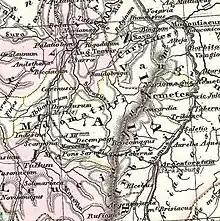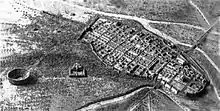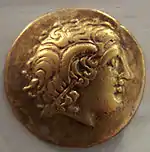Mediomatrici
The Mediomatrici (Gaulish: *Medio-māteres) were a Belgic tribe dwelling in the present-day Lorraine region during the Iron Age and the Roman period.


Name
They are mentioned as Mediomatricorum and Mediomatricis (dat.) by Caesar (mid-1st c. BC),[1] Mediomatrikoì (Μεδιοματρικοὶ ) by Strabo (early 1st c. AD),[2] Mediomatrici by Pliny (1st c. AD),[3] Mediomatricos (acc.) by Tacitus (early 2nd c. AD),[4] and as Mediomátrikes (Μεδιομάτρικες) by Ptolemy (2nd c. AD).[5][6]
The ethnonym Mediomatrici is a Latinized form of the Gaulish *Medio-māteres, which literally means 'Middle-Mothers'. It is formed with the root medio- ('in the middle, central') attached to a plural form of mātīr ('mother'). The name could be interpreted as meaning 'those who live between the Matrona (Marne) and the Matra rivers' (i.e. the mother-rivers), or possibly as the 'Mothers of the Middle-World' (i.e. between the heaven and the underworld).[7]
The city of Metz, attested ca. 400 AD as civitas Mediomatricorum ('civitas of the Mediomatrici'), is named after the Celtic tribe.[8]
Geography
History
During the Gallic Wars (58–50 BC), the Mediomatrici sent 5,000 men to support Vercingetorix who was besieged in Alesia in 52.[16][9] In 69–70 of the Common Era, their capital Divodurum was sacked by the armies of Vitellius, and 4,000 of its inhabitants massacred.[16] The Romanization of the Metromatrici was apparently slower compared to their neighbours the Treviri.[17][10]
Elements of the Mediomatrici may have settled near Novara, in northwestern Italy, where place-names allude to their presence, such as Mezzomerico, attested as Mediomadrigo in 980.[18]
References
- Caesar. Commentarii de Bello Gallico. 4:10, 7:75.
- Strabo. Geōgraphiká, 4:3:4.
- Pliny. Naturalis Historia, 4:106.
- Tacitus. Historiae, 4:70.
- Ptolemy. Geōgraphikḕ Hyphḗgēsis, 2:9:7.
- Falileyev 2010, s.v. Mediomatrici.
- Delamarre 2003, pp. 220, 222.
- Nègre 1990, p. 155.
- Schön 2006.
- Demougin 1995, p. 193.
- Berggren, J. L.; Jones, Alexander (2000). Ptolemy's Geography: An Annotated Translation of the Theoretical Chapters. Princeton University Press. p. 103. ISBN 978-0-691-01042-7.
- Delamarre 2003, p. 156.
- Nègre 1990, p. 175.
- Petit & Santoro 2016.
- Antonelli & Petit 2017.
- Demougin 1995, p. 183.
- Wightman 1985, pp. 73–74.
- Ambrogio, Renzo, ed. (2006). Nomi d'Italia : origine e significato dei nomi geografici e di tutti i comuni. Istituto geografico De Agostini. p. 384. ISBN 88-511-0983-4. OCLC 605741780.
Footnotes
- From Gaulish deuos 'god' attached to duron 'gates' > 'enclosed town, market town').[12]
Bibliography
- Antonelli, Sonia; Petit, Jean-Paul (2017). "L'agglomération de Bliesbruck (Moselle) durant l'Antiquité tardive : entre ruptures et continuités". Gallia. Archéologie des Gaules. 74 (74–1): 149–164. doi:10.4000/gallia.2428. ISSN 0016-4119.
- Delamarre, Xavier (2003). Dictionnaire de la langue gauloise: Une approche linguistique du vieux-celtique continental. Errance. ISBN 9782877723695.
- Demougin, Ségolène (1995). "À propos des Médiomatriques". Cahiers du Centre Gustave Glotz. 6: 183–194. doi:10.3406/ccgg.1995.1608. ISSN 1016-9008. JSTOR 24359561.
- Falileyev, Alexander (2010). Dictionary of Continental Celtic Place-names: A Celtic Companion to the Barrington Atlas of the Greek and Roman World. CMCS. ISBN 978-0955718236.
- Nègre, Ernest (1990). Toponymie générale de la France. Librairie Droz. ISBN 978-2-600-02883-7.
- Petit, Jean-Paul; Santoro, Sara (2016). "Le centre public d'une agglomération secondaire de la cité des Médiomatriques : Bliesbruck (Moselle)". Gallia. Archéologie des Gaules. 73 (73–2): 213–283. doi:10.4000/gallia.2734. ISSN 0016-4119.
- Schön, Franz (2006). "Mediomatrici". Brill's New Pauly. doi:10.1163/1574-9347_bnp_e728280.
- Wightman, Edith M. (1985). Gallia Belgica. University of California Press. ISBN 978-0-520-05297-0.

